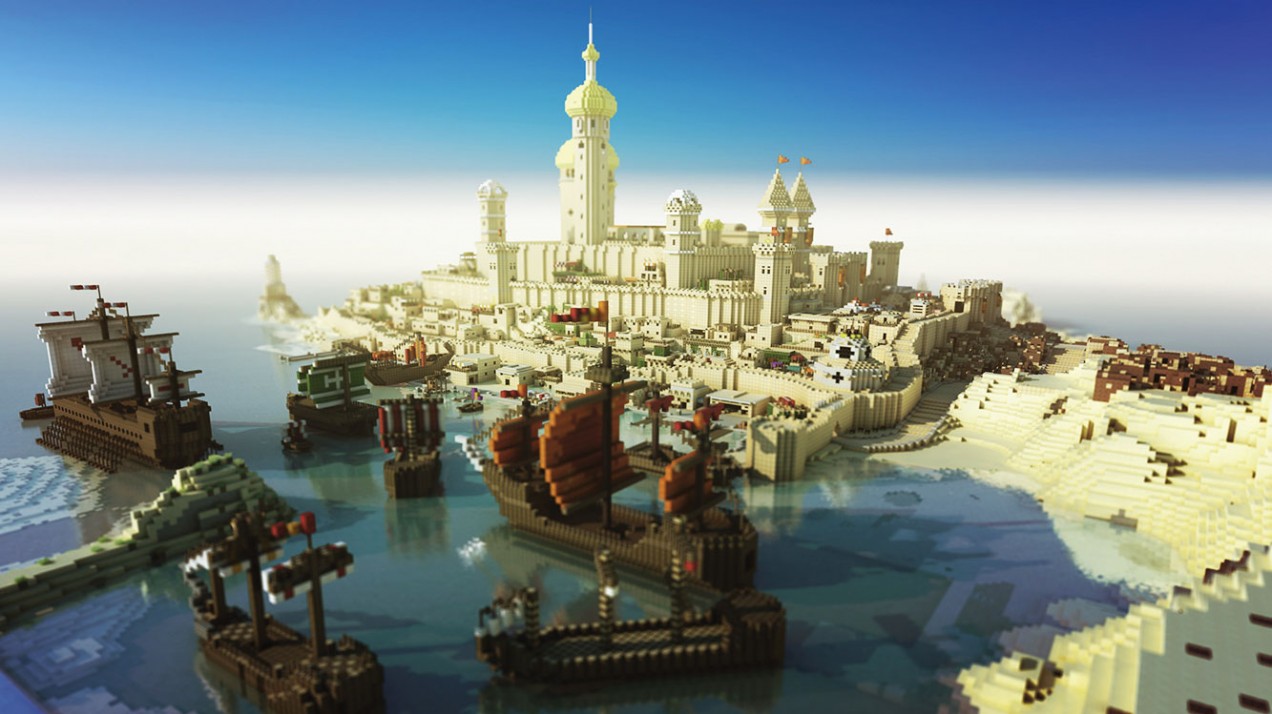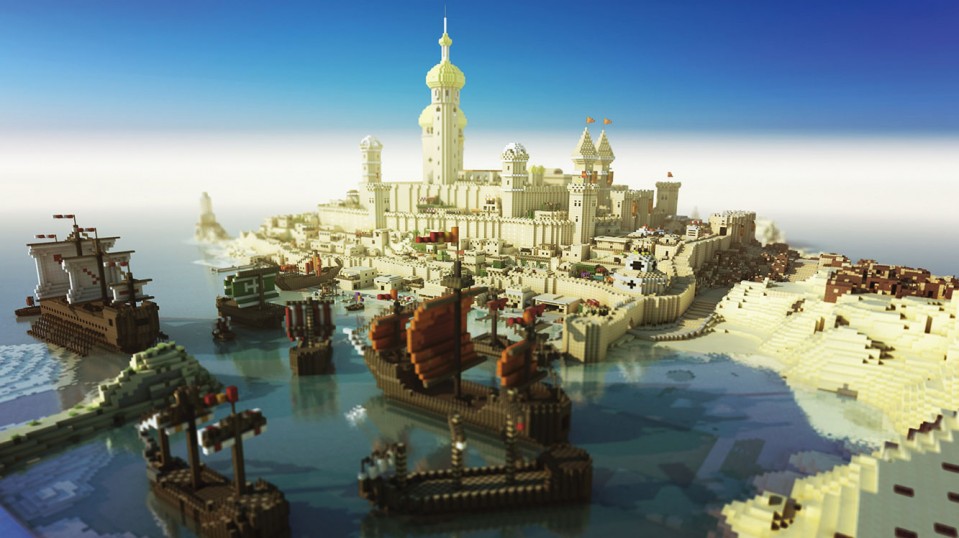

Intelligent Machines
The Secret to a Video-Game Phenomenon
By eschewing grit and realism for creativity and simplicity, Minecraft shows how bedroom programmers can create global hits.

All video-game makers are minor gods. They are, after all, in the business of world creation. The game creator sets down the mountains and arranges the valleys in his or her world. The creator decides upon the sky’s hue, the water’s viscosity, the pitch of birdsong, and the force of gravity’s pull. The creator types “Let there be light” (or the C# equivalent) and there is light. The creator chooses how and when night falls and whether or not there will be a new dawn. The creator conjures how time works (linear, malleable, or something else entirely) and writes the strands of code that form the incumbent creatures’ DNA. Then, when everything is planned out, the creator clicks “RUN” to execute a Big Bang.
Among such gods, Markus Persson, the Swedish creator of Minecraft—a video game that has, in the four years since its initial release, become a 21st-century sensation, played in bedrooms and classrooms around the world—is something of a Zeus. More than 22 million people have paid to immigrate to his world and settle there (nearly three times as many as live in the gigantic multiplayer game World of Warcraft), be it on PC, smartphone, or video-game console. Released without backing from investors or publishers, Minecraft is inspiring a new generation of independent game makers to strike out on their own, and to approach their medium in new ways. Meanwhile, the profits it’s generated—$86 million in 2012 alone—rival those of the world’s largest entertainment releases.
Such incomparable success is unexpected. Minecraft embodies few of the video-game fashions that were current when it appeared. Coded in Java, a general-purpose programming language that emphasizes speed and lightness over the grand capabilities of more powerful tools, it features pixelated scenery that has nothing in common with the lifelike, polygon-stuffed characters and objects furnishing the blockbuster video games of the day. There is a certain Lego-like charm and blunt handsomeness to the rectangular clouds that throw shadows on the game’s pea-green hills and the dumpy sheep that roam them. But in an industry traditionally obsessed with chasing realism and authenticity, its kindergarten aesthetic at first appears anachronistic.
Moreover, where the creators of big-budget games are now as much movie directors as gods—shepherding their players through scenes and treating their characters like actors, with scripted lines of dialogue and stage directions—Minecraft places its players in the game’s world with few directives. There are almost no goals or commandments to guide or moderate behavior, apart from those of the players’ own making. So what accounts for the game’s success? Its intelligent design reveals a watchmaker’s precision, while the elemental freedom it offers its inhabitants taps into some primal, irresistible human urges.
In the beginning you’re given your own algorithmically generated world (each new game creates an expanse of blocky geology that nobody, not even Persson, has seen before), and little more than the title functions as a clue to your tasks: to mine and to craft. These twin abilities—destruction and creation—are mapped to the game’s two main buttons. Press one and your stumpy arm will flail in front of you with comic speed and repetition, chipping away at whatever object you’re looking at, eventually reducing it to a floating cube of material that may be collected and stored in your inventory. The nature of the harvest is dependent on the material you “mined.” Chopping a tree will produce a block of wood. Chopping a cliff face will yield a chunk of granite. Hammer the beach and you’ll nab a cube of sand.
With these raw materials you are free to build. At first you might experiment with a waist-high wall, laying blocks side by side in a straight line. Now, emboldened by your success, you turn it into one of the four walls of a small house, blocking out the light with a flat roof before knocking through the door you neglected to account for in the original design. Meanwhile, the sun has wheeled in the sky, unnoticed by the novice. Night falls and the eerie sounds of scratching monsters arise. At this point Minecraft’s ambiance shifts, and you realize that as well as a playpen for the imagination, this is also a world of peril.
You retreat into your creation or, if it remains unfinished, hurriedly hollow out a cave in the side of a mountain in which to quiver and cringe till morning, when the skeletons and zombies dissipate and you’re free to return to your construction. The game’s rhythm established—build during the day, shelter during the night—you continue with the chaotic implementation of your half-cocked ideas. The hut becomes a shack becomes a lodge becomes a house becomes a mansion becomes a castle. Through a rudimentary tutorial you learn that certain blocks require certain tools, and using a craft bench you begin to fashion simple utensils: a pickax, a shovel, a hoe, a sword. As the range of blocks you’ve harvested diversifies, the range of domestic features you can build widens, and soon your abode is furnished with candles, paintings, elaborate stairwells, and bay windows.
The pleasure of construction is matched by the thrill of destruction, our play reflecting the very rhythms of life: birth, death, and rebirth. Minecraft understands that for humans, the business of creation is closely linked to the business of survival. The threat of the nighttime monsters brings focus to your industry, while the richness of materials found in the world facilitates the personal touch, encouraging craftsmanship.
Perhaps this would be enough to make Minecraft a million-seller, but what has turned success into sensation is the social aspect of the game. Not only are players encouraged to head out of its confines onto YouTube to share tips or show off their grand designs, but the game also allows for communal construction projects, in which players can visit one another’s worlds and collaborate on virtual pyramids, a scale replica of the Taj Mahal, or a fully mapped Westeros, the fictional land from HBO’s television series Game of Thrones. The inclusion of giant, hand-built logic gates has enabled some smart players to build functioning computers, scrawled boastfully into the landscape, while other players have opted to simply journey to the center of the earth.
Last year this indie game overtook Activision’s blockbuster war game Call of Duty as the most played title on Microsoft’s Xbox Live. The implications of this feat are wide ranging. For one, it shows that a creation game rather than a shooting game can rise to dominance. It also confirms that contrary to big-publisher wisdom, players are more interested in expressive and interesting interactions than simple graphical prowess, whose charms are fleeting.
For a generation of young game makers, empowered by more accessible tools and ubiquitous platforms including mobile devices, the game provides commercial inspiration. In a medium that sprang from student endeavor and bedroom programming only to see the power inevitably shift to companies and, eventually, megacorporations, it’s again possible for the bedroom programmer to become a multimillionaire. Since Minecraft’s rise to prominence, hundreds of young players have been inspired to make their own games, either through structured learning in schools or by using free or cheap tools such as GameMaker on their own. Thanks to Minecraft’s example and the ease of self-publishing through channels such as the Apple App store, Google’s Play Store, and Steam, independent video-game studios are enjoying an unprecedented burst of success.
Fitting then, perhaps, that Persson’s purpose with the game is somewhat evangelical, although it isn’t revealed until the closing credits. While Minecraft’s loose, player-defined goals are its strongest draw, there is an endgame for those who feel the need to beat a video game rather than simply enjoy one. If at this stage a giant dragon is discovered and felled, that will conclude the story line. The reward for defeating the dragon is a poem, written by the Irish novelist Julian Gough, that describes Minecraft as a dream. It reads:
This player dreamed of sunlight and trees. Of fire and water. It dreamed it created. And it dreamed it destroyed. It dreamed it hunted, and was hunted. It dreamed of shelter … And the player started to breathe faster and deeper and realised it was alive, it was alive, those thousand deaths had not been real, the player was alive … And the game was over and the player woke up from the dream. And the player began a new dream. And the player dreamed again, dreamed better.
Minecraft’s mainstream appeal may not lie in the poetry tucked away in an endgame few will see, but it is to be found in this poetry’s sentiment. Here is a game that enables humans to experience an accelerated form of existence—of dominion but also of stewardship. It makes clear the ancient ties between creativity and survival, and the wonder of collaboration, coöperation, and community, both in its world and in the reality on the other side of the screen. This is a recipe that demonstrates how video-game design, in the right hands, can be elevated to an art form every bit as strange and wonderful as any other, revealing deep truths about the human condition.
Simon Parkin is the author of The Illustrated History of Video Games (Anness Publishing).